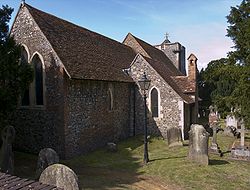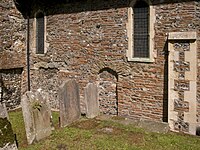St Martin's Church, Canterbury
| Church of St Martin | |
|
Canterbury, Kent | |
|---|---|
| Status: | Parish church |
 St Martin's Church | |
| Church of England | |
| Diocese of Canterbury | |
| Location | |
| Grid reference: | TR15865776 |
| Location: | 51°16’41"N, 1°5’37"E |
| History | |
| Information | |
| Website: | www.martinpaul.org |
The Church of St Martin in Canterbury, Kent, situated slightly beyond the city centre, is the first church founded in England, the oldest parish church in continuous use and the oldest church in the entire English-speaking world. As such, it is recognised, along with Canterbury Cathedral and St Augustine's Abbey, as part of a World Heritage Site.
Since 1668 the church has been part of the benefice of St Martin and St Paul Canterbury. Both St Martin's and nearby St Paul's churches are used for weekly services.
Early history
St Martin's was the private chapel of Queen Bertha of Kent in the 6th century before Augustine arrived from Rome. Queen Bertha was a Christian Frankish princess who arrived in Kent with her Chaplain, Bishop Liudhard. King Æthelberht of Kent, her pagan husband, allowed her to continue to practise her religion by renovating (ca. AD 580) an existing church which the Venerable Bede says had been in use in the Roman period but had fallen into disuse. As Bede specifically names it, this church was dedicated to Saint Martin of Tours, a city located near where Bertha grew up.
Upon Augustine's arrival he used St Martin's as his mission headquarters, immediately enlarging it (AD 597), and King Æthelberht was soon baptised here. With the quickly subsequent establishments of Canterbury Cathedral and St Augustine's Abbey, St Martin's lost prestige but retains its priority and historical importance.
Shortly before 1844, a hoard of gold coins which may date from the late 6th century was found in the churchyard, one of which is the Liudhard medalet, which bears an image of a diademed figure with a legend referring to Liudhard.[1]
Architecture

Local finds prove that Christianity did exist in this area of the city at the time, and the church contains many reused Roman bricks or spolia, as well as complete sections of walls of Roman tiles. At the core of the church the brick remains of a Roman tomb were integrated into the structure[2] Several sections of walls are clearly very early, and it is possible that a blocked square-headed doorway in the chancel was the entrance to Bertha's church, while other sections of wall come from the period after the Gregorian mission in the 7th or 8th centuries, including most of the nave. The apse that was originally at the east end has been removed.[3] The tower is much later, in Perpendicular style. The church is a Grade I listed building.
Music
The church has a strong continuing musical tradition from the monks of St Augustine to the present day. The choral director for the parish is Dom del Nevo.
 |
 |
 |
Outside links
| ("Wikimedia Commons" has material about St Martin's Church, Canterbury) |
References
- ↑ Grierson, Philip: 'The Canterbury (St. Martin's) Hoard of Frankish and Anglo-Saxon Coin-Ornaments' (Dark Age Numismatics: Selected Studies, 1979)
- ↑ Thurley, Simon: 'Making England: The Shadow of Rome, 410-1130' (2010, Gresham College)
- ↑ Service, pp. 14-17 and: John Julius Norwich, The Architecture of Southern England, p.313, Macmillan, London, 1985, ISBN 0-333-22037-4
- F. Haverfield, "Early British Christianity" The English Historical Review Vol. 11, No. 43. (Jul., 1896)
- Service, Alastair, The Buildings of Britain, A Guide and Gazetteer, Anglo-Saxon and Norman, 1982, Barrie & Jenkins (London), ISBN 0-09-150131-8
| World Heritage Sites in the United Kingdom |
|---|
|
Bath • Blaenavon Industrial Landscape • Blenheim Palace • Canterbury Cathedral, St Augustine's Abbey & St. Martin's Church • Castles and Town Walls of King Edward I • Cornwall and West Devon Mining Landscape • Derwent Valley Mills • Durham Castle & Cathedral • Edinburgh Old Town & New Town • Forth Bridge • Frontiers of the Roman Empire: Antonine Wall & Hadrian's Wall • Giant's Causeway • Ironbridge Gorge • Jurassic Coast • Kew Gardens • Liverpool Maritime Mercantile City • Maritime Greenwich • New Lanark • Heart of Neolithic Orkney • Pontcysyllte Aqueduct • St Kilda • Saltaire • Stonehenge, Avebury & Associated Sites • Studley Royal Park & Fountains Abbey • Tower of London • Palace of Westminster, Westminster Abbey & St Margaret's Church |
